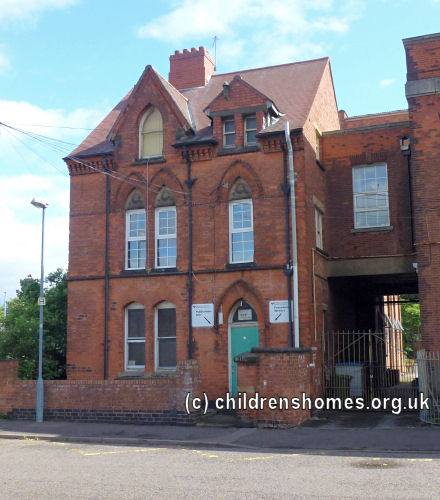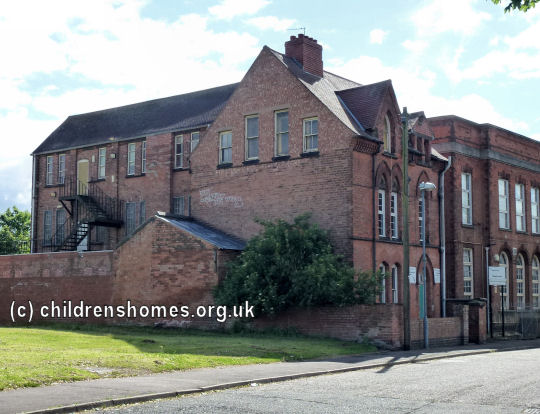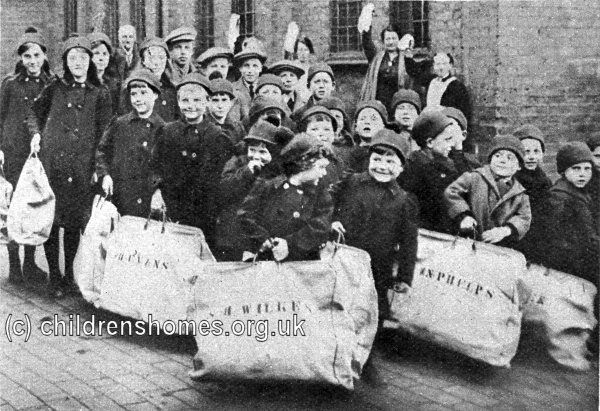Children's (Middlemore) Emigration Homes, Birmingham, Warwickshire
In 1872, the Children's Emigration Homes in Birmingham were founded by John Throgmorton Middlemore (1844-1924), the son of a wealthy leather manufacturer. After finishing school, Middlemore spent time travelling in Canada and in the USA where he had relatives, and gained a degree in medicine at the University of Brunswick, Maine. After he returned to Birmingham, he became interested in the plight of the city's orphan and destitute children. Like others of his day, Middlemore believed that emigration to a new life in Canada offered the best opportunity for such children. The homes he established were intended to give children practical training to prepare them for life and work in their new country. The girls were taught domestic skills, while the boys learned manual trades.
The first home, for boys, was opened in August, 1872, at 105 St Luke's Road, in the Highgate area of Birmingham. At the end of 1872, a home for girls was opened a short distance away at 36 Spring Street. A third home followed at 94 Summer Road. In around 1877, a large new building for boys was opened at 157 St Luke's Road. This was subsequently enlarged to include a section for girls and the other homes were then closed. The expanded premises, which occupied 157 to 161 St Luke's Road, could accommodate 90 boys and 60 girls, aged from 7 to 14.

157 St Luke's Road, Birmingham, 2013 © Peter Higginbotham

157 St Luke's Road, Birmingham, 2013 © Peter Higginbotham
After making arrangements for their reception in Toronto, Middlemore set sail for Canada with his first party of 26 children on May 1st, 1873, on board the SS Sarmatian. A further group of fifty children made the crossing in May, 1874, aboard the Prussian. In 1875, a receiving home for Middlemore children was established at London, Ontario. The home, known as Guthrie House, continued in use until its lease expired in May, 1879. In its place, Middlemore purchased a building known as Swartz's Tavern which took on the name of the Guthrie Home.
As well as children from his own homes, from 1887 onwards Middlemore also took children to Canada on behalf of other institutions such as workhouses and reformatory schools. These included the Wolverhampton, Chelsea, St Olave's and St George in the East unions the Shustoke Industrial School. Conversely, children from the Middlemore homes were sometimes taken across with other emigration organisers such as Annie Macpherson.
The Guthrie Home appears to have closed in the early 1890s and was replaced by new premises known as Fairview, just outside Halifax, Nova Scotia, with John S Rough as its Superintendent. Apart from a suspension in emigration during the First World War, Fairview continued in operation until 1932 by which time it is estimated that more than five thousand children had emigrated through the Middlemore homes.
Middlemore served on Birmingham Town Council from 1883 to 1892, was elected Member of Parliament for Birmingham North in 1899, and was made a Baronet in 1919. However, he continued his active involvement in the homes until his death in October, 1924. In recognition of his work, the Emigration Homes were renamed the Middlemore Homes in 1925.

Middlemore Emigration Party, 1920. © Peter Higginbotham
From the mid-1920s, Canada became more restrictive in its policy towards child emigration. In its place, Australia gradually became the main destination for British 'Home Children', with many children from the Middlemore Homes starting their new lives at the Fairbridge Farm School in Western Australia.
In 1928, The Middlemore Homes moved to new purpose-built premises on Weoley Park Road, Selly Oak. The U-shaped building was designed by the firm of Buckland and Hayward. A babies' home was added to the establishment in May, 1939.
Following a steep decline in numbers emigrating to Australia after 1948, the Weoley Park Road property was leased to the Birmingham City Council who used it a children's home known as Middlemore House. The home closed in 1955 and the site later became part of Westhill College. The former home building was demolished in 2004.
Middlemore's work is now continued by the Sir John Middlemore Charitable Trust which supports small non-profit organisations working with children and young people.
All that now survives of the various Middlemore Homes' buildings is 157 St Luke's Road which, at the time of writing, was being used by the City Council for administrative purposes.
Records
Note: many repositories impose a closure period of up to 100 years for records identifying individuals. Before travelling a long distance, always check that the records you want to consult will be available.
- Birmingham Archives and Heritage Service, Library of Birmingham, Centenary Square, Broad Street, Birmingham B1 2ND. Holds the Middlemore Homes archives including: Admission registers (1873-1954); Homes entrance books (1873-1854); Annual reports (1873-1967). Emigration-related holdings include Application books (1887-1937); Settlements and reports books (1876-1909); History books (1873-1891).
- Library and Archives Canda, 395 Wellington Street, Ottawa, Ontario. Holds microfilm copies of the Middlemore Homes archives.
- British Isles Family History Society of Greater Ottawa (BIFHSGO). . Has online indexes to Middlemore Homes emigration-related records.
Census
Bibliography
- Middlemore Homes Committee One Hundred Years of Child Care (1972)
- Roberts-Pichette, Patricia Great Canadian Expectations: The Middlemore Experience (2016, Global Heritage Press)
- Roberts-Pichette, Patricia John Throgmorton Middlemore and the Children's Emigration Homes (No date)
- Bagnell, Kenneth The Little Immigrants: The Orphans Who Came to Canada (2001, Dundurn)
- Birt, Lilian M The Children's Home-Finder: the story of Annie Macpherson and Louisa Birt (1913, J. Nisbet)
- Corbett, Gail H Nation Builders: Barnardo Children in Canada (2002, Dundurn)
- Higginbotham, Peter Children's Homes: A History of Institutional Care for Britain's Young (2017, Pen & Sword)
- Kershaw, Roger and Sacks, Janet New Lives for Old: The Story of Britain's child migrants: The Story of Britain's Home Children (2008, The National Archives)
- Kohli, Marjorie The Golden Bridge: Young Immigrants to Canada 1833-1939 (2003, Natural Heritage Books)
- McEvoy, Frederick J 'These Treasures of the Church of God': Catholic Child Immigration to Canada (in CCHA, Historical Studies, 65 (1999), 50-70)
- Parker, Roy Uprooted: The Shipment of Poor Children to Canada, 1867-1917 (2010, Policy Press)
Links
- Sir John Middlemore Charitable Trust
- British Home Children in Canada.
- Home Children Canada — British Home Children Registry.
- British Home Child Group International — has database of over 23,000 Canadian British Home Children
- National Library and Archives Canada especial the Home Children section.
- British Isles Family History Society of Greater Ottawa (BIFHSGO) — has several indexes of the names of children brought to Canada by various organizations in the 19th and early 20th centuries.
- FindMyPast — Home Children Canada Immigration Records Index, 1869-1930.
- Young Immigrants to Canada. [Archived]
- National Archives of Australia — Immigration Records.
- Good British Stock — Australian National Archives research guide.
- Personal History Index for former Child Migrants to Catholic homes in Australia.
Except where indicated, this page () © Peter Higginbotham. Contents may not be reproduced without permission.


